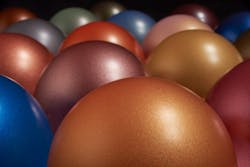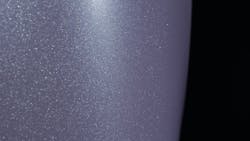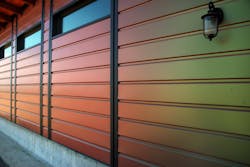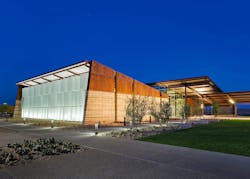Special Effects: Going Beyond the Color Spectrum for Exteriors
When the original Fluropon® line debuted in 1965, the architectural metal coating was only available in five colors. Today, Valspar, now part of Sherwin-Williams Coil Coating, offers over 25,000 colors, a testament to innovations over the years that have paved the way for more possible applications of exterior coatings. Along with the increasing range of paint hues, there are new eye-catching effects and coating patterns now available for AEC teams to choose from to enhance their building projects.
Valspar’s senior project chemist for extrusion coatings, Nancy Peden Schuster, works to expand the limits of color by creating new color spaces and effects. Her job allows her to constantly try out new ideas in the lab, blending an artist’s eye with technical knowledge. “It’s really fun because I have the freedom to basically just try any look I can imagine,” she said.
Schuster has been instrumental in creating the Fluropon Effects line that features rich, dimensional colors with a layer of sparkle and color shifting. Valspar’s three main Fluropon Effects lines — Nova, Rustica, and Kameleon — meet AAMA 2605 performance specs and are available in coil and extrusion coatings. Each are 70 percent PVDF coatings, formulated to perform outdoors, and able to resist fading and chalking.
Nova, introduced in 2015, gives a gold or silver sparkle to almost any color without compromising color integrity. Whites can sparkle, yet remain clean. Schuster explains that prior to the launch of the Nova line, many paints would lose their true color when the sparkle of mica was added. With Nova, she was able to develop a dramatic sparkling coating that would still perform and not mute the base color, letting the black, blue, or red shine through.
Rustica, introduced last year, is a color palette made up of rich, nature-inspired colors like Amber, Dark Bronze, and Green Flash. The line showcases natural, polychromatic colors with a weathered look.
The third, Kameleon, collection gives off an iridescent, color-shifting effect depending on the light or angle. The color shifts can be subtle or dramatic.
Another trending option is the use of prints, which are used to create patterns like wood grain, slate, and corten steel on metal. These involve using a base coat and a layer of ink to create the desired effect. Prints are commonly used to create effects on wall panels, and they’re growing in popularity in the roofing market.
Creating colors that will perform outside, however, can still remain a challenge. Schuster can create essentially any color she wants in the lab, but if it doesn’t perform in the exterior environment, it’s back to the drawing board. “We’ve been testing formulations for over 30 years at our testing facility in Fort Meyers, FL,” she said. “We know what doesn’t work and what will perform. When we formulate we have guidelines on which materials will withstand extreme outdoor environments — so when we say a product is going to last, we mean it.”
Schuster added that the company is always innovating and offering customized coating options. Whether it’s special effects, solids, matte, textures, or prints, they are always trying to capture an architect’s vision with each of the coatings offered. Today’s AEC teams are looking for colors beyond the traditional silvers, beiges, and neutrals. Valspar works closely with architects to customize options and find the perfect coating for a project. For Schuster, it’s an exciting time to work in the industry.
“We’re trying to embrace modern culture with color, while highlighting new effects that go beyond the normal,” Schuster said.



